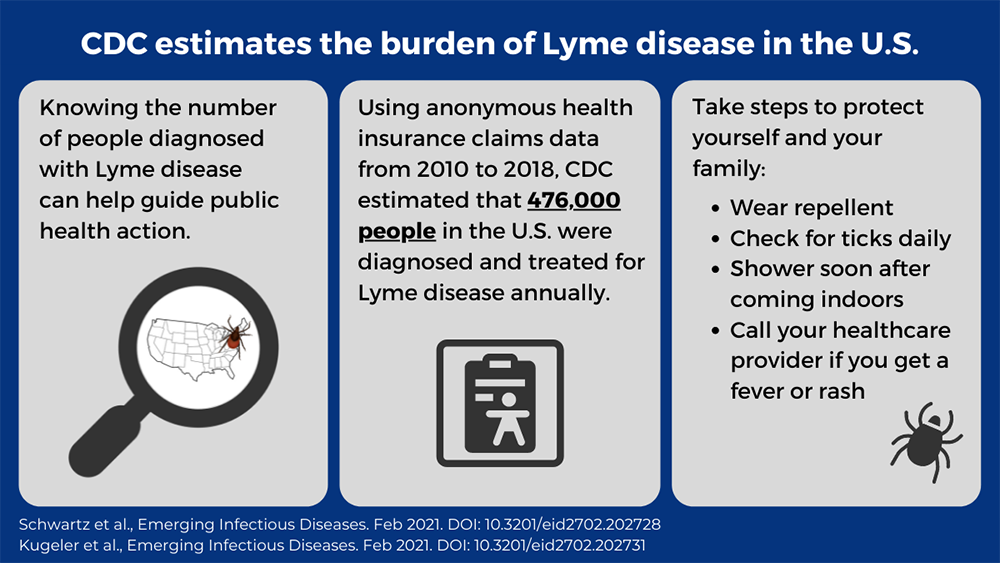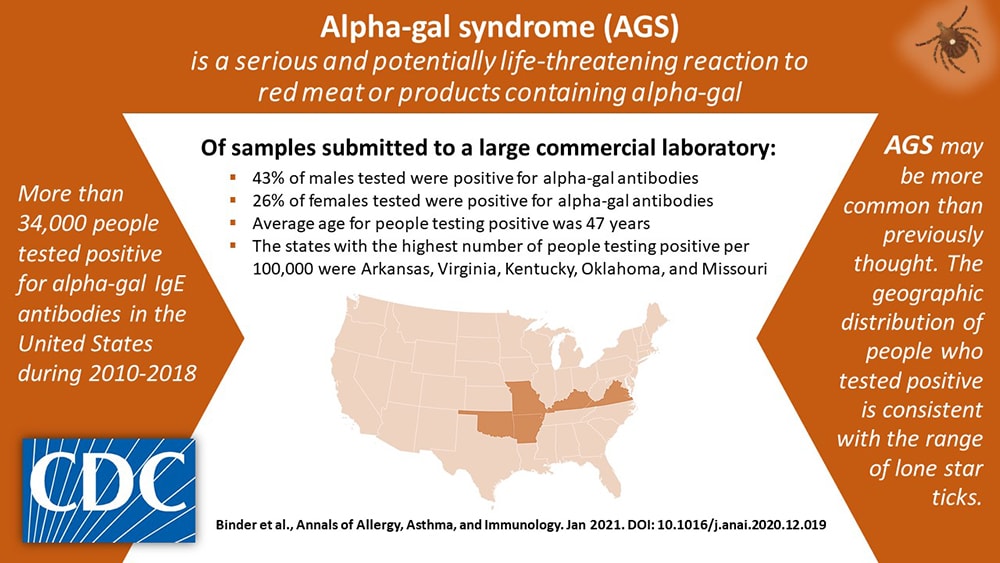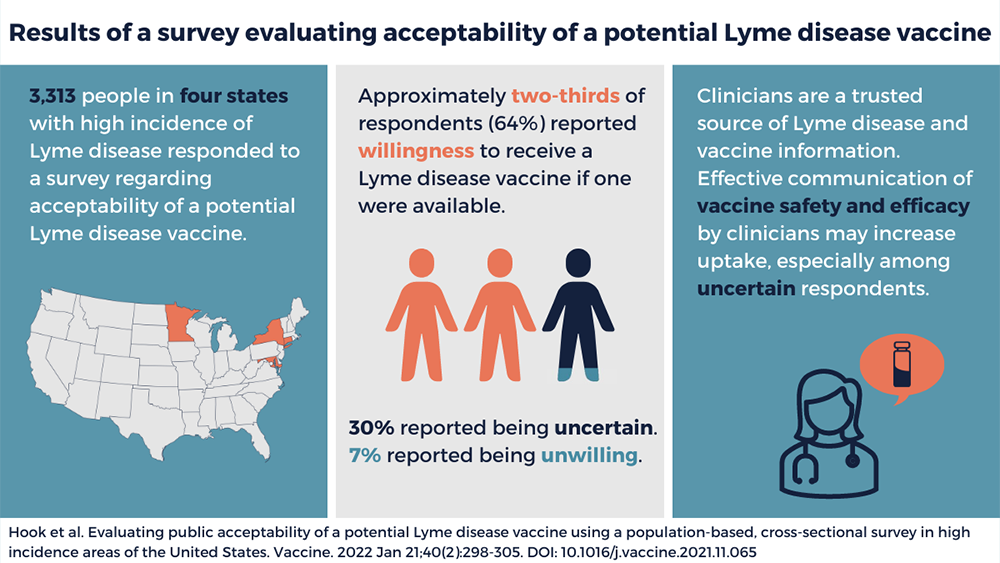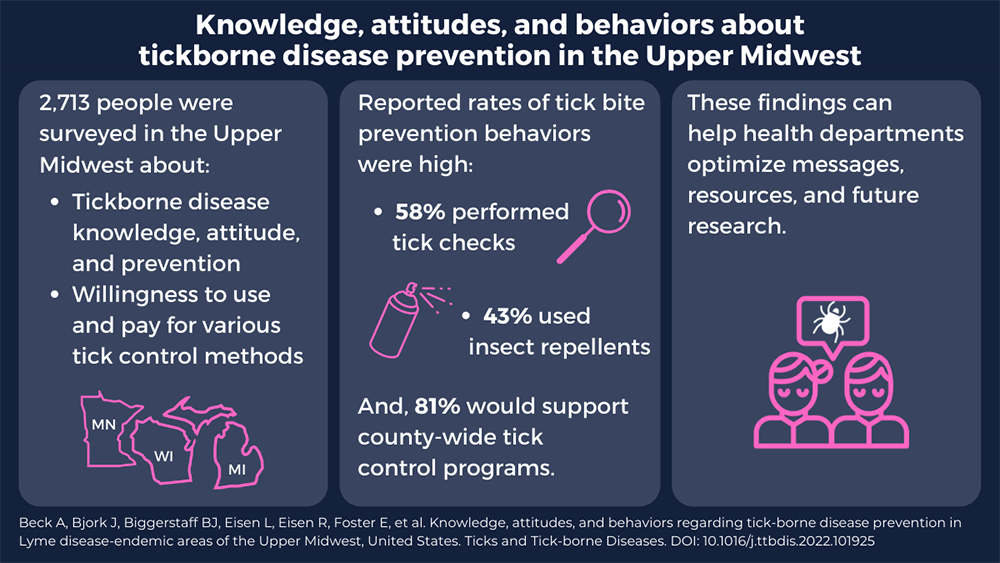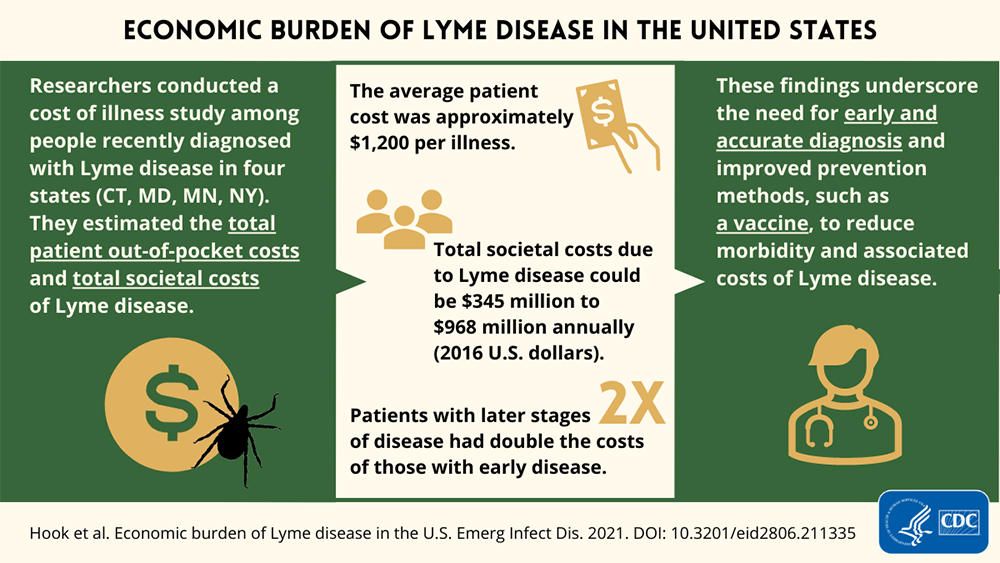Understanding Lyme and Other Tickborne Diseases
Tickborne diseases increasingly threaten the health of people in the United States. Improved understanding about reported tickborne illnesses, expanding geographic ranges for ticks, and risk factors will help prevent and control tickborne disease. New tools for preventing tickborne diseases are urgently needed, and everyone can take steps to help protect themselves from tick bites.
COVID-19 pandemic and tickborne disease reporting
CDC expects that the COVID-19 pandemic will result in fewer cases of Lyme and other tickborne diseases being reported by state health departments in 2020 and 2021. These decreases in reported cases likely result from the effects of the COVID-19 pandemic on tickborne disease surveillance rather than an actual decrease in the numbers of tickborne diseases. Data shows that during the pandemic people continued to spend time outdoors and seek information on tick removal. However, medical care for tick bites and testing for tickborne diseases like Lyme disease may have been reduced compared to prior years.
Surveillance is more than counting cases
Understanding the full effects of tickborne diseases on human health requires more than counting numbers of people getting the disease. It requires studying the timing, the location, and costs of the infections. To supplement data from traditional surveillance techniques, CDC began several new efforts to better understand the burden of tickborne diseases:
- In 2021, CDC released a Tick Bite Data Tracker that shows emergency department (ED) visits for tick bites on a week-by-week and regional basis. The visual dashboard lets people across the country know when they are most at risk and gives healthcare providers and public health personnel access to timely data that can improve tick bite prevention efforts.
- A 2021 estimate based on insurance records suggests that each year approximately 476,000 Americans are diagnosed and treated for Lyme disease. CDC continues to pursue other records-based methods of estimating tickborne disease diagnoses.
- CDC recently published research that shows the economic burden of Lyme disease in the United States is between $345 million and $968 million each year (2016 U.S. dollars). Additionally, the average patient cost was approximately $1200 per infection and patients with later stages of disease had double the costs of those with early disease.
Taken together, these findings underscore the need for early and accurate diagnosis of tickborne diseases and improved prevention tools, including vaccines to reduce the number of people infected by, and costs associated with tickborne diseases.
Complicated interactions between people and nature
A number of factors likely contribute to the increasing case numbers and widening geographic extent of tickborne diseases. For example, the spread of Lyme disease over the past several decades has been linked to changes in land use patterns, including reforestation in the northeastern United States. Suburban development in these areas has brought people, deer, rodents, ticks, and the germs ticks carry into close contact with each other.
Changing climate patterns can alter the natural environment and longstanding ecological relationships. Since tickborne diseases have strong environmental links, we expect that changes in seasonality and location may occur. We don’t know what those changes will be, but we know that climate is only one of several very important factors that influence the distribution and occurrence of tickborne diseases.
Every year is a big year for tickborne diseases
Predicting the number of Lyme disease, anaplasmosis, Rocky Mountain spotted fever, or Powassan virus cases is complicated. In any given year, the number of ticks in an area will be different from region to region, state to state, and even county to county. Numbers of reported tickborne disease cases are also affected by healthcare provider awareness and by testing and reporting practices.
However, each year nearly half a million people will be diagnosed and treated for a tickborne disease. In that sense, every year is a big year for tickborne diseases.
Know about risks in your area
Knowing that thousands of people are bitten by ticks and get sick each year, people should take steps to avoid ticks in the areas where they live, work and play. While not all ticks spread the same germs, ticks can be found in every state. However, in the United States, some diseases occur more frequently in some areas than others:
- Reported cases of Lyme disease, anaplasmosis, babesiosis, and Powassan virus disease are concentrated in the Northeast, mid-Atlantic, and upper Midwest, with pockets of risk along the Pacific coast. The range of the tick that transmits Lyme disease also is expanding.
- Other serious tickborne diseases include Rocky Mountain spotted fever, ehrlichiosis, and Rickettsia parkeri rickettsiosis. More than 75 percent of spotted fever rickettsiosis cases (including RMSF) occur in seven states: Arkansas, Missouri, North Carolina, Oklahoma, Virginia, Alabama, and Tennessee.
- Growing evidence suggests that alpha-gal syndrome, or red meat allergy, may be triggered by the bite of lone star ticks and possibly other tick species. A recent study showed that the states with the highest number of people testing positive for alpha-gal antibodies per 100,000 were Arkansas, Virginia, Kentucky, Oklahoma, and Missouri.
Take steps to protect against tick bites
Taking steps to protect yourself and your family from getting a tick bite is the best defense against tickborne diseases. CDC recommends that people:
- Avoid areas with high grass and leaf litter and walk in the center of trails when hiking.
- Use Environmental Protection Agency (EPA)-registered insect repellentsexternal icon containing DEET, picaridin, IR3535, oil of lemon eucalyptus, para-menthane-diol, or 2-undecanone. EPA’s search toolexternal icon can help you find the product that best suits your needs. Always follow product instructions.
- Use products that contain permethrin to treat clothing and gear, such as boots, pants, socks and tents or look for clothing pre-treated with permethrin.
- Treat dogs for ticks. Dogs are very susceptible to tick bites and to some tickborne diseases. They may also bring ticks into your home. Talk to your veterinarian about the best tick prevention products for your dog.
- Bathe or shower as soon as possible after coming indoors to wash off and more easily find crawling ticks before they bite you.
- Conduct a full-body tick check using a hand-held or full-length mirror to view all parts of your body upon returning from tick-infested areas. Parents should help children check thoroughly for ticks. Remove any ticks right away.
- Put dry clothes in a dryer on high heat for 10 minutes to kill ticks after you come indoors. If clothes are damp, dry thoroughly and then tumble dry on high for 10 more minutes.
Highlights from Recent CDC Tick Studies
- Tick Bite Data Tracker
- Tickborne Disease Surveillance Data Summary
- Vital Signs: Illnesses on the rise from mosquito, tick, and flea bites
- MMWR: Trends in Reported Vectorborne Disease Cases — United States and Territories, 2004–2016
- Alpha-gal allergy
- Asian longhorned ticks: A new tick in the United States
- CDC Ticks Portal
- Preventing Tick Bites
- Geographic Distribution of Ticks that Bite Humans
- Tick Surveillance
- Tick Life Cycle and How Ticks Spread Disease
- How Many People get Lyme Disease?
- Lyme Disease Frequently Asked Questions
- Lyme Disease Educational Materials
- Tickborne Disease Research Collaborations at CDC
- Diagnosis and Management of Tickborne Rickettsial Diseases: Rocky Mountain Spotted Fever and Other Spotted Fever Group Rickettsioses, Ehrlichioses, and Anaplasmosis — United States
- Research on Doxycycline in Children
- Anaplasmosis
- Babesiosis
- Ehrlichiosis
- Rocky Mountain Spotted Fever
- RMSF is Deadly, yet Preventable
- Hunter Safety Tips pdf icon[PDF – 2 pages]
- Printable Babesiosis Resources (fact sheets, tick check cards, poster)



